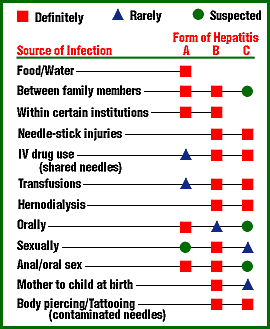


Direct percutaneous exposure is the most efficient method for transmitting HCV. In drug users, HCV infection is acquired rapidly after beginning injection drug use, with 50-80 percent of new users becoming positive for antibody to HCV within 6-12 months. Injection drug use accounts for half of all new infections annually and perhaps greater than 50 percent of chronic infections. In addition, it is thought that the majority of the rest of the cases can be explained by transfusion prior to 1990, occupational exposures to blood, hemodialysis, high-risk sexual activity (multiple partners, history of sexually transmitted diseases), and noninjection illegal drug use (intranasal cocaine). Percutaneous exposures such as body piercing and tattooing are potential sources of transmission if contaminated equipment or supplies are used, although their role in transmission of HCV in the United States has not been confirmed. It is now considered that the route of transmission is unknown in less than 10 percent of newly acquired cases of hepatitis C.
Military Service is another means of transmission. Thousands of Vietnam Veterans are now turning up with HCV. It is believed many got it through tainted blood transfusions and tainted Gamma Globulin shots. Another form of Military transmission is the Jet Injector's used to issue vaccines to military personnel.
Data regarding transmissibility by sexual contact have been conflicting. Based on studies in sexually transmitted disease clinics, sexual transmission appears to occur; however, even with multiple sexual partners the risk is low. The risk appears to be increased by coinfection with HIV or other sexually transmitted diseases. Although transmission in long-term monogamous relationships may occur, the risk is thought to be minimal.
There is some evidence for occupational and nosocomial transmission of HCV infection. Health care workers have a higher prevalence than the general population, although many may have acquired it from other sources. However, inadvertent needle stick injuries and lack of application of universal precautions may be contributing factors. The risk of infection from needle sticks in hepatitis C is intermediate between that of HIV and hepatitis B. HCV transmission between patients in dialysis centers may be related to poorinfection control practices. Although transmission from health care workers to patients has been documented, such transmission is thought to be rare.
Perinatal transmission between mother and baby has been documented, although the risk is estimated at no more than 6 percent. The risk is increased if the mother is coinfected with HIV. Although data are limited, there is no evidence that breast-feeding transmits HCV from mother to baby.